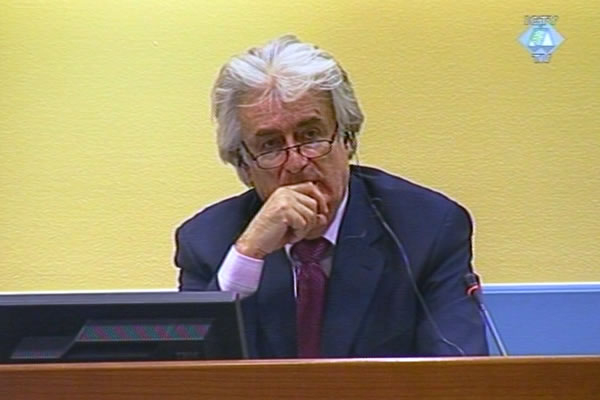Home
‘RAISING DOUBTS’ ABOUT SARAJEVO INVESTIGATIONS FINDINGS
Continuing his cross-examination of Mirza Sabljica, Radovan Karadzic tried to ‘make an overview of all the inconsistencies’ in the investigations of sniper and artillery incidents, in order to ‘raise reasonable doubts’ about their results. Karadzic wants to prove what in fact happened, in his view
 Radovan Karadzic in the courtroom
Radovan Karadzic in the courtroom Radovan Karadzic continued his cross-examination of ballistic expert from the Sarajevo Security Services Center, Mirza Sabljica. Karadzic contested the responsibility of the Serb forces for sniper and artillery incidents in Sarajevo, insisting there were mistakes in the investigations. Karadzic also spoke of other circumstances that could, in his view, ‘raise reasonable doubt’ as to the findings of the investigations and the allegations by the prosecution.
The indictment against Karadzic lists an incident in which a mortar shell hit Alipasino Polje on 22 January 1994, killing six children and injuring five persons. At the crime scene, the investigation team from the Sarajevo Security Services Center established that the shell had been fired from a westerly direction. The Institute for the Blind was to the west of the impact site, in Nedzarici, part of Sarajevo controlled by the Bosnian Serbs.
Karadzic put it to the witness that in its report, the investigation team identified the Institute for the Blind as a ‘potential location’ from which the shell ‘could have been’ fired. The separation line ran near the Institute for the Blind; the Vojnicko polje neighborhood, the Oslobodjenje building and the students’ halls of residence were all located behind the Institute, in the territory controlled by the BH Army.
Karadzic noted there were discrepancies between the UNPROFOR report and the report of the Sarajevo investigation team as to the caliber of the shells that hit the spot where the children were killed and injured. Karadzic also put it to the witness that the investigation would have been more precise if the snow had been cleared from the impact site.
Karadzic then focused on the incident of 1 June 1993 when a mortar shell killed eight and injured about 100 persons; the victims were players and spectators at a football match in the Dobrinja neighborhood. Karadzic wanted to know ‘from what distance can one hear the sound of a shell being fired’, the difference between asphalt and macadam and how many players there are in five-a-side football.
This prompted the judges to enquire as to the relevance of those questions. Karadzic explained he wanted to ‘make an overview of all the inconsistencies’ in the findings of various investigations of sniper and artillery incidents in order to ‘raise reasonable doubt’ and prove what really happened, according to him.
As he probed the incidents in which trams were targeted by snipers, Karadzic put it to the witness that the task of the investigation teams was to ‘rule out the BH Army positions’ from their reports and to blame the Serb side. The witness rejected the claim, noting that the investigators were able to do their job ‘without any pressure from military or political organizations’. The witness added that the purpose of investigations was not to levy any political accusations at any side but to identify those who committed crimes.
As the hearing today drew to a close, Karadzic started his analysis of the Markale incident on 5 February 1994. Radovan Karadzic is expected to complete his cross-examination of Mirza Sabljica in the course of the first session tomorrow.
Linked Reports
- Case : Karadzic
- 2010-10-12 KARADZIC REJECTS SARAJEVO INVESTIGATIONS
- 2010-10-11 THOUSAND DAYS OF UNCERTAINTY
- 2010-10-08 KARADZIC HAD ABSOLUTE CONTROL
- 2010-10-14 KARADZIC: WE NEED RECONCILIATION THIS YEAR, NOT NEXT
- 2010-10-15 TRIBUNAL EXPECTS BH TO COOPERATE VOLUNTARILY
- 2010-10-18 TERROR AND HORROR IN SARAJEVO
